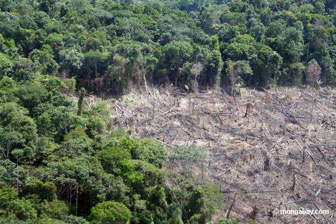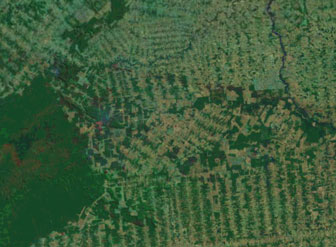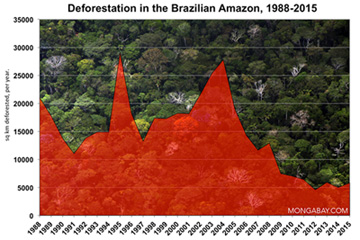Fragmentation reduces biodiversity in the Amazon rainforest and worsens global warming
Fragmentation reduces biodiversity in the Amazon rainforest and worsens global warming
Rhett Butler, mongabay.com
November 27, 2006
Forest fragmentation is rapidly eroding biodiversity in the Amazon rainforest and could worsen global warming according to research to be published this week in the journal Proceedings of the National Academy of Sciences.
“Rainforest trees can live for centuries, even millennia, so none of us expected things to change too fast. But in just two decades-a wink of time for a thousand year-old tree-the ecosystem has been seriously degraded.” said Dr. William Laurance, a scientist at the Smithsonian Tropical Research Institute in Panama and leader of the international team of scientists that conducted the research.
The study, based upon observations of nearly 32,000 Amazonian trees since 1980, found that fragmentation causes profound changes to forest dynamics and ecology, resulting in the disappearance of rare species and forest specialists.
As large tracts forest are increasingly chopped into smaller blocks, edge effects alter the flora and fauna of forests. Fragmented patches of forest are subject to drying winds that increase the frequency of tree falls. Tree falls tear gaps in the canopy, destroying its function of moderating the humidity, temperature, and heat conditions of the forest floor. These changes affect the species that inhabit the forest patch, usually reducing diversity. Many rare species that dwell in the deep primary forest are unable to cope with the new conditions and are replaced by more common, weedier species.
  Deforestation in the Amazon. Top photo courtesy of Google Earth, bottom photo by Rhett A. Butler. |
“The winners are common pioneer and generalist species that like forest disturbance,” said Laurance. The team studied 22 different characteristics of increasing and declining species. “Most vulnerable are trees specialized for life in the dark forest understory and that need animals such as birds or bats to disperse their seeds and pollen,” said Henrique Nascimento, of Brazil’s National Institute for Amazonian Research in Manaus. “When you fragment rainforest, hot winds from the surrounding pastures kill many trees, which just can’t handle the stress,” he added.
The researchers say that fragmentation is destabilizing forest dynamics by driving high turnover rates among tree species as large trees lose out to small, fast-growing species.
Fragmentation may also have global climate impact since fragments experience a considerable die-off of trees attributed to drying winds and storms. As the vegetation dies and decomposes, more carbon is added to the atmosphere. In addition, forest fragments are characterized by “weedier” fast-growing species which store less carbon per volume than longer-lived trees with high density wood. Therefore such fragmented and disturbed forest has a diminished carbon storage capacity relative to undisturbed primary rainforest. Other studies have found that fragmented forests may suffer up to a 36 percent loss of biomass in the first few years after fragmentation. The drier forest conditions also mean that agricultural fires set in the surrounding scrub land and savanna are more likely to burn through the forest patch. The problem extends to ecosystems outside the Amazon as well: more than two-thirds of the world’s remaining forests are fragmented.
“Fragmentation is affecting the forest in a lot of ways,” said Laurance. “These changes occur remarkably fast, and when you completely alter something as basic as the trees, the other species that live in the rainforest will surely be affected too.”

DEFORESTATION IN BRAZIL: 60-70 percent of deforestation in the Amazon results from cattle ranches while the rest mostly results from small-scale subsistence agriculture. Logging results in forest degradation but rarely direct deforestation. However, studies have showed a close correlation between logging and future clearing for settlement and farming. Graphic by R. Butler. |
The Amazon is Earth’s biggest rainforest, but since the early 1970s about 650,00 square kilometers (250,000 square miles), or 18 percent of the forest area — have been destroyed. In recent years road construction, clearing for agriculture and cattle pasture, and logging have been responsible for most forest loss. Scientists say that continued forest loss could turn much of the Amazon rainforest into savanna, putting the region’s biodiversity at risk — the Amazon may be home to as much as one-third of the planet’s terrestrial species.
Since 2002 the Brazilian government has moved to reign in forest clearing by setting aside more than 100 million hectares of the Amazon basin from development and cracking down on illegal activities. These efforts, combined with lower commodity prices may be paying off: forest loss for the 2005-2006 year was down more than 40 percent from the prior year. The 2005-2006 figure — 13,100 square kilometers (5,057 square miles) — is the lowest since 1991 when 11,130 square kilometers (4,258 square miles) of forest were lost.
This article includes information from previous mongabay.com articles and the Smithsonian Tropical Research Institute.